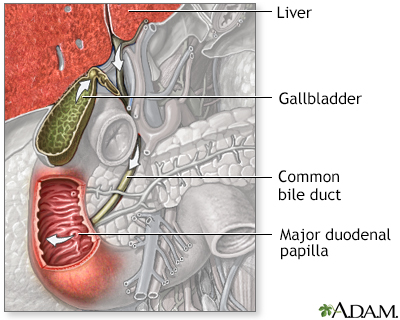Pregnancy SmartSiteTM
Primary sclerosing cholangitis; PSC DefinitionSclerosing cholangitis refers to swelling (inflammation), scarring, and destruction of the bile ducts inside and outside of the liver. CausesThe cause of this condition is unknown in most cases. The disease may be seen in people who have:
Genetic factors may also be responsible. Sclerosing cholangitis occurs more often in men than women. This disorder is rare in children. Sclerosing cholangitis may also be caused by:
SymptomsThe first symptoms are usually:
However, some people have no symptoms. Other symptoms may include:
Exams and TestsEven though some people do not have symptoms, blood tests shows that they have abnormal liver function. Your health care provider will look for:
Tests that show cholangitis include:
TreatmentMedicines that may be used include:
These surgical procedures may be done:
Outlook (Prognosis)How well people do varies. The disease tends to get worse over time. Sometimes people develop:
Some people develop infections of the bile ducts that keep returning. People with this condition have a high risk for developing cancer of the bile ducts (cholangiocarcinoma). They should be checked regularly with a liver imaging test and blood tests. People who also have IBD may have an increased risk for developing cancer of the colon or rectum and should have periodic colonoscopy. Possible ComplicationsComplications may include:
ReferencesAhrendt GM, Ahrendt SA. Gallbladder and biliary tree: Management of primary sclerosing cholangitis. In: Cameron AM, Cameron JL, eds. Current Surgical Therapy. 14th ed. Philadelphia, PA: Elsevier; 2023:457-538. Bowlus C, Assis DN, Goldberg D. Primary and secondary sclerosing cholangitis. In: Sanyal AJ, Boyer TD, Lindor KD, Terrault NA, eds. Zakim and Boyer's Hepatology. 7th ed. Philadelphia, PA: Elsevier; 2018:chap 43. Levy C, Bowlus CL. Primary and secondary sclerosing cholangitis. In: Feldman M, Friedman LS, Brandt LJ, eds. Sleisenger and Fordtran's Gastrointestinal and Liver Disease: Pathophysiology/Diagnosis/Management. 11th ed. Philadelphia, PA: Elsevier; 2021:chap 68. | |
| |
Review Date: 5/2/2023 Reviewed By: Michael M. Phillips, MD, Emeritus Professor of Medicine, The George Washington University School of Medicine, Washington, DC. Also reviewed by David C. Dugdale, MD, Medical Director, Brenda Conaway, Editorial Director, and the A.D.A.M. Editorial team. The information provided herein should not be used during any medical emergency or for the diagnosis or treatment of any medical condition. A licensed medical professional should be consulted for diagnosis and treatment of any and all medical conditions. Links to other sites are provided for information only -- they do not constitute endorsements of those other sites. No warranty of any kind, either expressed or implied, is made as to the accuracy, reliability, timeliness, or correctness of any translations made by a third-party service of the information provided herein into any other language. © 1997- A.D.A.M., a business unit of Ebix, Inc. Any duplication or distribution of the information contained herein is strictly prohibited. | |

 Digestive system
Digestive system Bile pathway
Bile pathway
